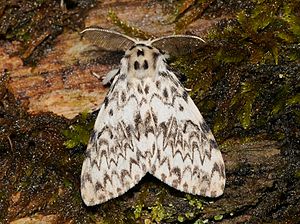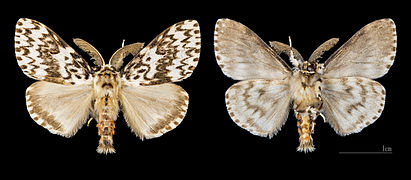Nun (butterfly)
| nun | ||||||||||||
|---|---|---|---|---|---|---|---|---|---|---|---|---|

Nun ( Lymantria monacha ), male |
||||||||||||
| Systematics | ||||||||||||
|
||||||||||||
| Scientific name | ||||||||||||
| Lymantria monacha | ||||||||||||
| ( Linnaeus , 1758) |
The nun ( Lymantria monacha ) is a butterfly ( moth ) from the subfamily of the bearer moth (Lymantriinae) within the family of the owl butterflies (Noctuidae).
features
The moths reach a wingspan of 30 to 50 millimeters. The females are significantly larger than the males. The basic color is white with many different thick and jagged dark bands and dots. Every now and then completely black individuals also appear. In the case of mass reproduction, even 50 percent of the new generation are almost black. The dark forms have a certain resemblance to the males of the gypsy moth . The hind wings are beige in color and have black points on the edge.
Similar species
- Gypsy moth ( Lymantria dispar ) (Linnaeus, 1758)
habitat
The nun can be found in dense spruce and pine forests . In some cases, mixed forests also serve as biotopes . The population fluctuates from year to year. There is a mass increase in an approximate cycle of three to five years.
Flight and caterpillar time
The flight time of a generation is between July and the beginning of September.
Way of life
The caterpillar season begins in late April and ends in June. The clutch is placed in small packages under bark or on smooth tree trunks under lichen . Usually this happens at the lower end of a tree, eggs are only found in the crowns with mass reproduction. A female lays up to 300 eggs, with each pile containing 20 to 100 eggs. The newly hatched caterpillars stay together - depending on the weather - for a few hours to days. This process is called "caterpillar mirror" by the foresters. Then the caterpillars climb into the crowns of the trees and spread out. If the wind prevails, the caterpillar stretches a thread, lets itself down and carried by the wind to another tree. This largely avoids intra-species competition. The female also contributes to this, because it selects trees that have not yet been infested to lay eggs.
Food, mode of action of mass populations
The caterpillars prefer spruce ( Picea abies ) and pine ( Pinus sylvestris ). In addition, silver fir ( Abies alba ), European larch ( Larix decidua ), aspen ( Populus tremula ), hornbeam ( Carpinus betulus ), common beech ( Fagus sylvatica ), English oak ( Quercus robur ), cultivated apple ( Malus domestica ) are used as caterpillar forage plants . Sycamore maple ( Acer pseudoplatanus ), bilberry ( Vaccinium myrtillus ) and bogberry ( Vaccinium uliginosum ). In spring, the animals feed on the first buds , then later on the needles. A caterpillar eats around 200 pine needles or 1,000 spruce needles and damages that many again when they bite off. Spruces die in 70 percent and pines in 90 percent needle loss. There is also a risk of damage due to the increased susceptibility to secondary infections from longhorn beetles, bark beetles, fungi or other pathogens. Therefore, mass reproductions of the nun can cause great damage in forestry , such as B. before and after the First World War .
In order to prevent the mass reproduction of the nun, infected trees should be removed immediately. Forest cultures that are not appropriate to the location increase the risk and are more severely affected by gradations , which is why it is advisable to convert such forests into sparse mixed stands . As a preventive measure, the population development should be constantly observed. If such prophylactic measures are out of the question, such mass reproductions can be countered with chemical or biological measures, i.e. with the use of poisons such as cyhalothrin , or antagonists such as viruses, bacteria or parasitic wasps .
distribution
The species is distributed from the north of the Iberian Peninsula across western and central Europe (including southern England) to the temperate zone of East Asia. The northern border of the distribution area runs from Oslo , Uppsala , Saint Petersburg , Perm and between the 43rd and 57 degrees north latitude to Japan . The southern border stretches from central Spain via Corsica , along the Dalmatian coast, through northern Greece and the European part of Turkey to the Black Sea .
swell
Individual evidence
- ↑ a b Günter Ebert: The Butterflies of Baden-Württemberg Volume 4, Moths II (Bombycidae, Endromidae, Lemoniidae, Saturniidae, Sphingidae, Drepanidae, Notodontidae, Dilobidae, Lymantriidae, Ctenuchidae, Nolidae). Ulmer Verlag Stuttgart 1994. ISBN 3-800-13474-8
- ↑ see below a. Forester Weisswange: The fight against the nun . Neumann, 1914 or E. Knoche: Pest, Climate and Control . Arb. Biolog. Reichsanstalt, Vol. XVI, H. 4, 1928
- ↑ Jens Blankennagel: Controversial insecticide use in Brandenburg: From Monday, "Liquid Karate" will fall from the sky. In: berliner-kurier.de . May 3, 2019, accessed May 4, 2019 .
literature
- Gustav Wellenstein (also publisher) and others: The nun in East Prussia (1933-1937). Field studies of the forest station for pest control in Jagdhaus Rominten. Parey, Berlin 1942
- Wolfgang Schwenke (Hrsg.) Among others: The forest pests of Europe. A manual in 5 volumes. Volume 3: Butterflies . Parey, Hamburg and Berlin 1978, ISBN 3-490-11316-0
- Fritz Schwerdtfeger : The forest diseases. Textbook of forest pathology and forest protection. 4th revised edition, Parey, Hamburg and Berlin 1981, ISBN 3-490-09116-7
Web links
- Lepiforum e. V. Taxonomy and Photos
- www.schmetterling-raupe.de
- Lymantria monacha (L.) - Nun, Black Arches ( Memento from August 21, 2008 in the Internet Archive )
- various images: males, females, larvae, eggs, feeding picture ( memento from March 26, 2004 in the Internet Archive )
- Moths and Butterflies of Europe and North Africa (English)
- Guide to the moths of Great Britain and Ireland (English)
- Markku Savela: Lepidoptera and some other life forms (English)
- Collection of the Natural History Museum Stockholm (Swedish)
- Lymantria monacha in Fauna Europaea



